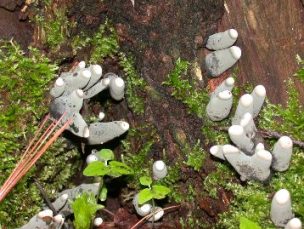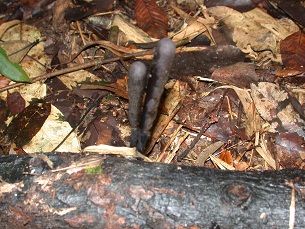Classification
Domain: Eukarya
Supergroup: Opisthokonta
Kingdom: Fungi
Phylum: Ascomycota
Class: Sordariomycetes
Order: Xylariales
Family: Xylariacaea
Genus: Xylaria
Species: Xylaria polymorpha
Below is the full classification of X. polymorpha
starting from domain and ending with species, along with a
description of why X. polymorpha is placed in each group (the taxonomy is
based upon the Species Fungorum website17 database and
the UW-La
Crosse organismal biology class lecture19).
Domain: Eukarya
X. polymorpha falls into the Eukarya domain because,
like all eukaryotes, at the cellular level there are membrane
bound organelles and a membrane bound nucleus containing linear
chromosomes and a nucleolus19.
Another cool member of Eukarya is
Cinnamomum zeylanicum.
Supergroup: Opisthokonta
Some scientists hypothesize that organisms in opisthokonta all
descended from an ancestor with a single posterior flagellum.
Organisms placed in opisthokonta also have conserved ribosomal
RNA sequences and proteins12. This super group
contains the animalia kingdom (which includes
organisms such as
Elephas maximus), fungi kingdom, and
some protists (e.g. choanoflagellates)19.
Kingdom: Fungi
Distinctive characteristics of X. polymorpha classify
it within the fungi kingdom. X. polymorpha does not
have specialized tissue for the transportation of materials. In
addition, X. polymorpha and most fungi undergo an
alteration of generations life cycle, with asexual and sexual
phases. All fungi use
spores as a part of reproduction,
which usually disperse via wind.
Most fungi are not motile, but grow as thread-like structures
called hyphae into an interwoven mesh called a mycelium. On the
other hand, some fungi grow in a single-celled yeast form.
A chitin based cell wall encloses the cell's of
most fungi19. To learn about the
magic mushroom found in the fungi kingdom,
Psilocybe cubensis, click the hyperlinked scientific name.
Phylum: Ascomycota
These fungi produce sexual spores in internal sacs called asci.
In addition, the ascomycota produce asexual spores externally
called
conidia. This group includes morels, cups, and other fungi, like
X. polymorpha
and
Saccharomyces cerevisiae19.
Class: Sordariomycetes
This class of fungi, along with X. polymorpha
and
Cordyceps sinesis, have flask shaped bodies
(perithecia) that contain
many asci. Most sordariomycetes have asci with eight spores
within each ascus. A well-known species in the this class is
Magnaporthe grisea, the pathogen that causes rice
blast16.
Order: Xylariales
Xylariales form a cushion-like plate of solid mycelium, called a stroma, and contain thick walled perithecia5,15. Pigmented ascospores with germ pores or
germ slits are another distinguishing characteristic of
xylariales. X. polymorpha possesses all of these
characteristics15.
Family: Xylariaceae
Along with the stroma and thick walled perithecia of
other Xylariales, X. polymorpha and fungi in
xylariaceae have an iodine-positive ascus apical ring. Most xylariaceae bear single-celled dark colored ascospores7. Xylariaceae range
in ecological roles, from mostly
decomposers of angiosperms to some plant pathogens to important endophytes11.
Genus: Xylaria
Xylaria grow into black,
firm club-like mature fruiting bodies. The Xylaria undergo complicated life cycles
with various forms and colors at each stage, often making
species identification difficult10.
Species: Xylaria polymorpha
The word "Xylaria" comes from the latin prefix xyl-
meaning wood, indicating this fungus grows on wood. "Polymorpha"
derives from the latin prefix poly - meaning many and the latin
suffix - morph meaning form or shape, indicating the multiple
forms of X. polymorpha that appear in nature9,18.
To learn about the phylogeny of Xylaria polymorpha, click the hyperlinked word to the left.